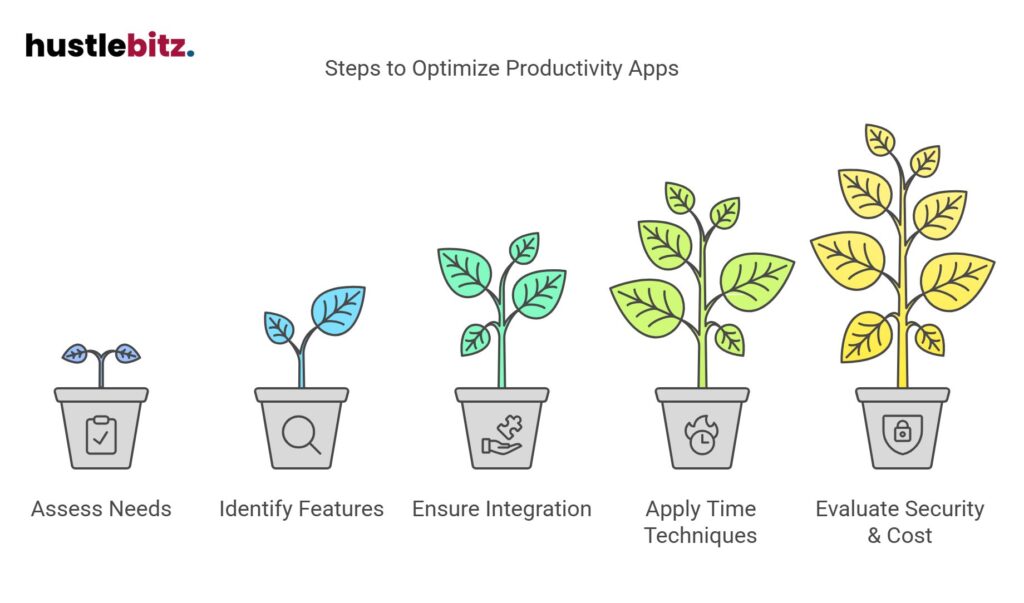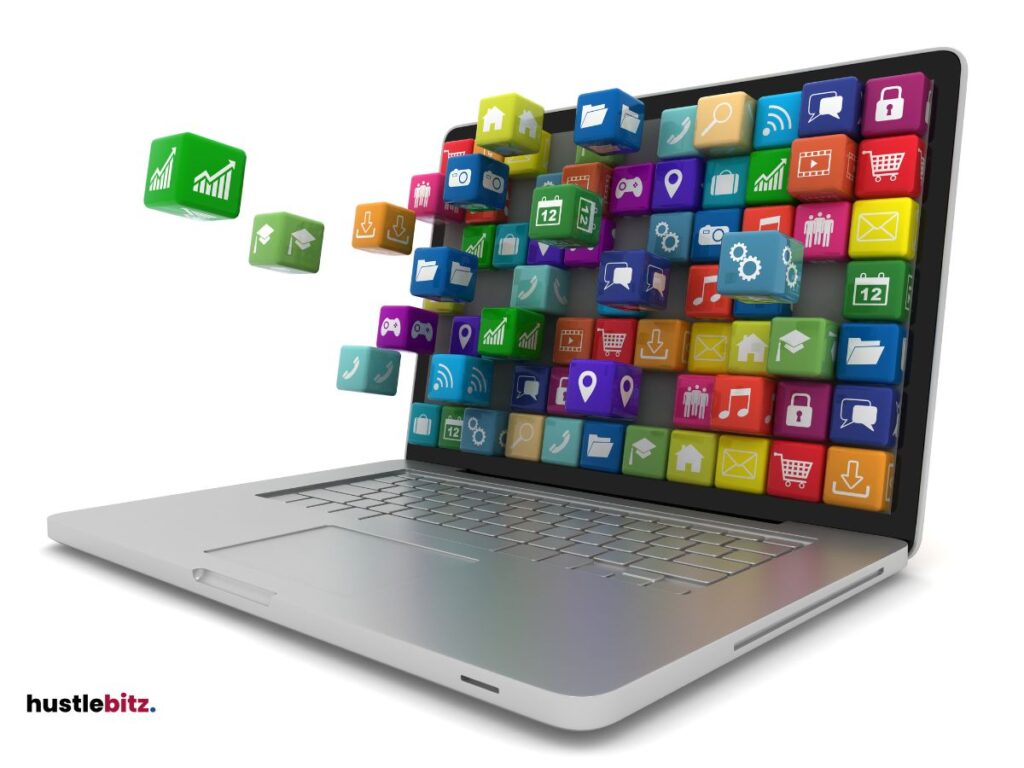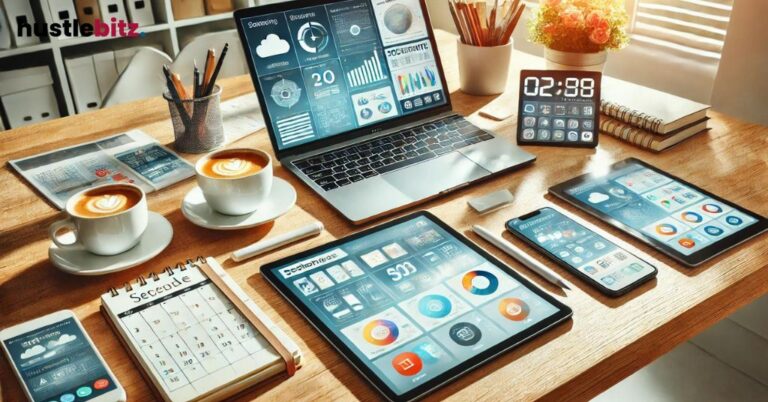Selecting the best productivity apps in 2024 demands a clear understanding of your unique productivity needs and workflows. Begin by assessing your goals, preferred work styles, and the features that matter most, such as task management, collaboration, and integration capabilities. Evaluate user interface, pricing transparency, and compatibility with existing tools. Additionally, consider apps that promote digital wellness and enhance focus. Explore categories like time management, note-taking, and workflow automation to find the ideal tools for your needs. By considering these factors, you position yourself for greater productivity and efficiency. Discover further insights to optimize your app selection process.
Key Takeaways
- Assess your specific productivity needs and workflows to ensure the chosen apps align with your goals and preferences.
- Look for key features such as task management, collaboration tools, and user-friendly interfaces for optimal functionality.
- Prioritize apps that integrate seamlessly with existing tools to enhance productivity and streamline workflows.
- Consider time management techniques like time blocking and the Pomodoro technique to improve focus and efficiency.
- Evaluate the security, offline capabilities, and pricing models of apps to ensure they fit your budget and requirements.

Understanding Your Productivity Needs

To effectively choose the best productivity apps in 2024, it is essential to first assess your specific productivity needs and workflows. Understanding your personal goals is crucial, as these objectives will guide you in selecting tools that align with your aspirations. Different productivity styles exist; therefore, it is important to identify which approach resonates with you. For instance, some individuals thrive in structured environments, while others prefer flexibility.
Consider your work environment and the unique time constraints you face. Are you often interrupted by digital distractions, or do you have the luxury of uninterrupted focus? Analyzing these factors will help you determine the type of app that can enhance your efficiency.
Furthermore, motivation factors play a significant role in sustaining productivity. If you find yourself easily distracted, look for apps with features that promote task prioritization and minimize interruptions.
Energy levels throughout the day can also impact how you approach your tasks. A productivity app that accommodates your natural rhythms can optimize your workflow, allowing you to tackle high-priority tasks when you are most energized.
Additionally, integrating self-discipline strategies within your workflow can enhance your ability to stay focused and committed.
Key Features to Look For

When evaluating productivity apps in 2024, it is crucial to identify key features that align with your specific needs, such as task prioritization, collaboration tools, and integration capabilities with other software.
One of the primary aspects to consider is the user interface; an intuitive, user-friendly design can significantly enhance your productivity. Additionally, robust customization options allow users to tailor the app to their unique workflows.
Pricing models also play a critical role in decision-making. It is essential to choose an app that offers transparent pricing and fits within your budget. Look for user reviews that provide insights into customer satisfaction and app performance, which can guide you in selecting a reliable tool.
Offline capabilities are another important feature, particularly for users who may not always have reliable internet access. Security features should not be overlooked; ensure that the app employs strong encryption methods to safeguard your data. Furthermore, platform compatibility is vital, as you’ll want an app that seamlessly integrates across your devices.
Evaluate the customer support offered, as responsive assistance can be a lifesaver during critical moments. Update frequency is also significant; regular updates indicate ongoing development and improvement, enhancing the app’s functionality over time.
Top Categories of Productivity Apps

In 2024, productivity apps can be categorized into several key types, each designed to address specific needs ranging from task management to time tracking and collaboration. Understanding these categories can help users select the most suitable tools for enhancing their productivity. Some notable categories include:
| Category | Description |
| Habit Tracking | Apps that facilitate the development of positive habits through goal setting and mindfulness practices. |
| Time Management | Tools that employ time blocking and focus techniques to optimize daily schedules and improve efficiency. |
| Workflow Automation | Applications designed to streamline processes, allowing users to automate repetitive tasks and enhance productivity metrics. |
Within these categories, users can explore features that support digital wellness, such as reducing distractions and promoting a balanced approach to work. For instance, habit tracking apps encourage users to set achievable goals while fostering mindfulness practices that contribute to overall well-being. Time management tools often incorporate project visualization techniques, enabling users to see their tasks in a structured format.
Moreover, workflow automation tools can significantly improve user experience by integrating different applications, ensuring that tasks flow seamlessly from one to another. By leveraging these categories of productivity apps, individuals and teams can effectively enhance their work habits, boost efficiency, and achieve their goals in a more organized manner.
Best Apps for Task Management
Effective task management is a vital component of productivity, and numerous apps have emerged in 2024 to help individuals and teams organize their responsibilities and streamline their workflows. These applications utilize various task prioritization techniques, allowing users to focus on what matters most, whether they prefer digital or paper solutions.
For individual users, apps often emphasize deadline management strategies that can help keep personal projects on track. Conversely, team-oriented platforms integrate collaboration features, enhancing communication and accountability. A key aspect of these tools is mobile app usability, which enables seamless access to tasks on-the-go, ensuring that users can manage their workloads from anywhere.
Task visualization methods, such as Kanban boards and Gantt charts, are increasingly popular, providing a clear overview of progress and deadlines. Moreover, automation in task management has gained traction, allowing repetitive tasks to be automated, thus freeing up time for more critical activities.
App customization options are vital for tailoring the user experience, enabling individuals to create workflows that align with their specific needs. Additionally, performance tracking metrics are essential for evaluating productivity levels, allowing users to assess their efficiency over time.
Lastly, user interface design plays a significant role in the overall experience; an intuitive layout can greatly enhance task management efforts, making it easier for users to navigate and utilize the app’s full potential.
Recommended Time Management Tools

Time management tools have become essential in 2024 for maximizing productivity and ensuring that individuals and teams can efficiently allocate their time towards achieving their goals. With the fast-paced nature of modern work environments, effective time management is crucial in maintaining focus and enhancing overall efficiency.
One popular approach is time blocking, which allows users to designate specific time slots for tasks, ensuring that daily routines are structured and prioritized. Coupled with the Pomodoro technique, where work is broken into intervals separated by short breaks, individuals can bolster their focus strategies while preventing burnout.
Goal setting remains a critical component of time management, enabling users to clearly define their objectives and align their daily tasks accordingly. By employing prioritization methods, individuals can identify the most critical tasks, which aids in overcoming procrastination and enhancing motivation techniques.
In addition to these strategies, time management tools also promote a healthy work-life balance. By integrating features that encourage digital detox, users can disconnect from screens, allowing for time to recharge and reflect. This holistic approach not only improves productivity but also fosters a sustainable lifestyle.
Ultimately, leveraging these recommended time management tools equips users with the necessary frameworks to effectively manage their time, leading to improved performance and satisfaction in both personal and professional spheres. Embracing these techniques will pave the way for a more organized and productive year ahead.
Collaboration and Communication Apps

Enhancing teamwork and communication is essential for productivity in today’s dynamic work environment, making collaboration and communication apps indispensable tools for organizations in 2024. These applications facilitate seamless interactions among team members, regardless of their physical locations, thus promoting effective remote collaboration.
Team messaging platforms are at the forefront of these tools, allowing for instant communication and real-time updates on projects. This immediacy supports efficient project coordination and fosters a culture of continuous feedback loops, essential for agile workflows. Furthermore, many of these apps integrate video conferencing functionalities, enabling face-to-face interactions that enhance engagement, especially during virtual brainstorming sessions.
Document sharing capabilities allow teams to collaborate on files simultaneously, ensuring that everyone is working with the most recent information. This cross-platform compatibility is vital, as it enables team members to access documents and updates on various devices, promoting flexibility and efficiency. Moreover, workflow automation features streamline repetitive tasks, freeing up valuable time for more strategic initiatives.
In 2024, organizations must prioritize collaboration and communication apps that not only enhance team dynamics but also support their specific operational needs. By leveraging these tools, teams can improve overall productivity, drive innovation, and adapt more readily to changing circumstances. Ultimately, the right collaboration app can transform how teams interact, making it a pivotal factor in achieving organizational goals.
Apps for Note-Taking and Organization
As collaboration tools facilitate communication among teams, the need for robust note-taking and organization apps becomes increasingly important to ensure that ideas and tasks are captured and managed efficiently.
The selection of the right app hinges on effective note-taking strategies and organization techniques that align with individual or team workflows.
In the digital age, professionals often grapple with the choice between digital vs. analog methods. Digital note-taking offers advantages such as easy searchability, accessibility across devices, and the ability to create collaborative notes.
Conversely, analog note-taking, such as handwriting in notebooks, can enhance retention and engagement for some individuals.
Best practices for note organization include categorizing notes by project or theme, utilizing tags, and employing visual note-taking techniques, such as mind mapping or sketching, to foster creativity and comprehension.
Additionally, mobile note-taking capabilities allow users to capture thoughts and ideas on-the-go, increasing productivity journaling opportunities.
When exploring various productivity apps, app comparisons can help identify features that best suit your needs, such as the ability to share notes, integrate multimedia, or provide templates for structured note-taking.
Ultimately, the ideal note-taking app should enhance your workflow, streamline note organization, and support collaborative efforts, thereby bolstering overall productivity.
Integration With Existing Tools

Seamless integration with existing tools is essential for maximizing the effectiveness of productivity apps in a professional setting. As organizations increasingly rely on a diverse software ecosystem, app compatibility challenges can hinder productivity if not adequately addressed.
When choosing a productivity app, it’s crucial to consider its ability to connect with the tools already in use, ensuring smooth workflow automation and minimizing disruptions.
To facilitate this integration, employing robust integration testing strategies is vital. This process helps identify potential syncing issues and resolves them before implementation. Furthermore, opting for applications that support cross-platform functionality enhances user experience by allowing team members to collaborate effortlessly, regardless of their devices or operating systems.
One of the significant advantages of modern productivity apps is their API usage benefits, which enable third-party integrations and facilitate data import/export options. By leveraging these APIs, businesses can streamline processes and enhance overall efficiency.
However, organizations must remain vigilant about user experience considerations; a poorly integrated app can lead to frustration, ultimately negating its intended benefits.
Moreover, evaluating the app’s alignment with the existing software ecosystem is critical. Ensuring that new tools complement and enhance current workflows can lead to greater adoption and improved productivity.
Final Thoughts
Choosing the best productivity apps in 2024 requires careful consideration of your unique needs, work styles, and the tools you already use. By focusing on key features such as task management, time tracking, collaboration, and seamless integration, you can select apps that truly enhance your efficiency and effectiveness. It’s essential to evaluate the user experience, pricing, and compatibility to ensure that the apps you choose align with your goals and workflows. By leveraging the right productivity tools, you can streamline your work processes, improve focus, and ultimately achieve better results in both your personal and professional life. As technology continues to evolve, staying informed and adaptable will help you make the most of the productivity solutions available, ensuring sustained success and growth.




